#20 July 1871
Text




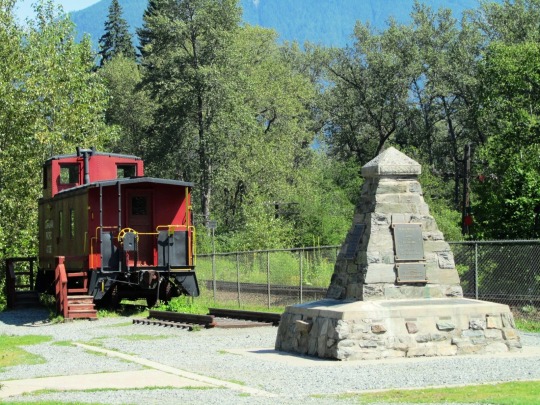




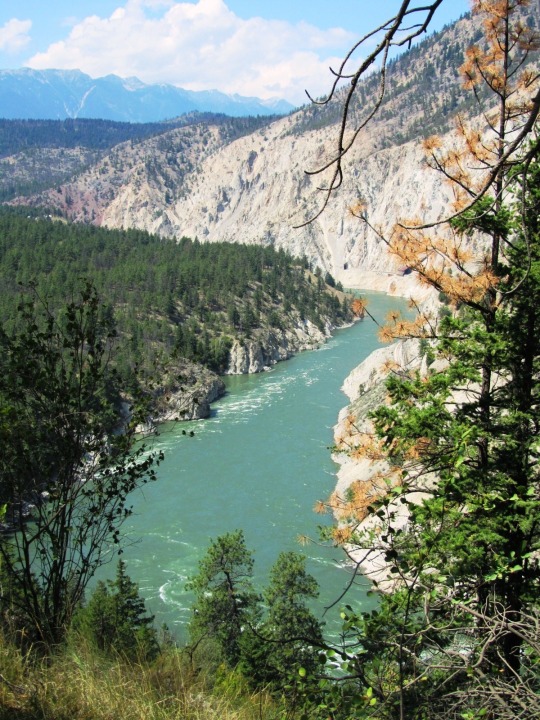




British Columbia joined the confederation of Canada on July 20, 1871.
#British Columbia#joined#Canada#travel#original photography#vacation#tourist attraction#landmark#cityscape#architecture#landscape#countryside#20 July 1871#anniversary#Canadian history#I'll be back this summer#summer 2012#Hope#Vancouver#Revelstoke#Kamloops Lake#Fraser River#Thompson River#Hells Gate#Yoho National Park#Rocky Mountains#Pacific Ocean
4 notes
·
View notes
Text
In fact, far more Asian workers moved to the Americas in the 19th century to make sugar than to build the transcontinental railroad [...]. [T]housands of Chinese migrants were recruited to work [...] on Louisiana’s sugar plantations after the Civil War. [...] Recruited and reviled as "coolies," their presence in sugar production helped justify racial exclusion after the abolition of slavery.
In places where sugar cane is grown, such as Mauritius, Fiji, Hawaii, Guyana, Trinidad and Suriname, there is usually a sizable population of Asians who can trace their ancestry to India, China, Japan, Korea, the Philippines, Indonesia and elsewhere. They are descendants of sugar plantation workers, whose migration and labor embodied the limitations and contradictions of chattel slavery’s slow death in the 19th century. [...]
---
Mass consumption of sugar in industrializing Europe and North America rested on mass production of sugar by enslaved Africans in the colonies. The whip, the market, and the law institutionalized slavery across the Americas, including in the U.S. When the Haitian Revolution erupted in 1791 and Napoleon Bonaparte’s mission to reclaim Saint-Domingue, France’s most prized colony, failed, slaveholding regimes around the world grew alarmed. In response to a series of slave rebellions in its own sugar colonies, especially in Jamaica, the British Empire formally abolished slavery in the 1830s. British emancipation included a payment of £20 million to slave owners, an immense sum of money that British taxpayers made loan payments on until 2015.
Importing indentured labor from Asia emerged as a potential way to maintain the British Empire’s sugar plantation system.
In 1838 John Gladstone, father of future prime minister William E. Gladstone, arranged for the shipment of 396 South Asian workers, bound to five years of indentured labor, to his sugar estates in British Guiana. The experiment with “Gladstone coolies,” as those workers came to be known, inaugurated [...] “a new system of [...] [indentured servitude],” which would endure for nearly a century. [...]
---
Bonaparte [...] agreed to sell France's claims [...] to the U.S. [...] in 1803, in [...] the Louisiana Purchase. Plantation owners who escaped Saint-Domingue [Haiti] with their enslaved workers helped establish a booming sugar industry in southern Louisiana. On huge plantations surrounding New Orleans, home of the largest slave market in the antebellum South, sugar production took off in the first half of the 19th century. By 1853, Louisiana was producing nearly 25% of all exportable sugar in the world. [...] On the eve of the Civil War, Louisiana’s sugar industry was valued at US$200 million. More than half of that figure represented the valuation of the ownership of human beings – Black people who did the backbreaking labor [...]. By the war’s end, approximately $193 million of the sugar industry’s prewar value had vanished.
Desperate to regain power and authority after the war, Louisiana’s wealthiest planters studied and learned from their Caribbean counterparts. They, too, looked to Asian workers for their salvation, fantasizing that so-called “coolies” [...].
Thousands of Chinese workers landed in Louisiana between 1866 and 1870, recruited from the Caribbean, China and California. Bound to multiyear contracts, they symbolized Louisiana planters’ racial hope [...].
To great fanfare, Louisiana’s wealthiest planters spent thousands of dollars to recruit gangs of Chinese workers. When 140 Chinese laborers arrived on Millaudon plantation near New Orleans on July 4, 1870, at a cost of about $10,000 in recruitment fees, the New Orleans Times reported that they were “young, athletic, intelligent, sober and cleanly” and superior to “the vast majority of our African population.” [...] But [...] [w]hen they heard that other workers earned more, they demanded the same. When planters refused, they ran away. The Chinese recruits, the Planters’ Banner observed in 1871, were “fond of changing about, run away worse than [Black people], and … leave as soon as anybody offers them higher wages.”
When Congress debated excluding the Chinese from the United States in 1882, Rep. Horace F. Page of California argued that the United States could not allow the entry of “millions of cooly slaves and serfs.” That racial reasoning would justify a long series of anti-Asian laws and policies on immigration and naturalization for nearly a century.
---
All text above by: Moon-Ho Jung. "Making sugar, making 'coolies': Chinese laborers toiled alongside Black workers on 19th-century Louisiana plantations". The Conversation. 13 January 2022. [All bold emphasis and some paragraph breaks/contractions added by me.]
456 notes
·
View notes
Text

Paul Valéry, October 30, 1871 – July 20, 1945.
31 notes
·
View notes
Text
Overwhelmed By Advertising? The Battle For Cincinnati Consumers Has Raged For More Than A Century
Depending on the source, it is estimated that each American is confronted by 6,000 to 10,000 advertising messages every single day. That immersive media onslaught swelled as we started carrying little video screens around wherever we go, but invasive and obnoxious marketing has bothered Cincinnatians for much more than a century.
For example, on 20 July 1871, a correspondent for the Cincinnati Times related an enjoyable voyage he had undertaken down the Ohio River. After praising the service of his riverboat’s staff, the remarkable scenery along the river, the picturesque little town he floated by, the writer registered one complaint, about a cliff near the town of Hanging Rock:
“High up on the face of this wall of white sandstone, hundreds of feet beyond the reach of a scaling ladder, I noticed a patent medicine advertisement. It was penciled there by a man let down with ropes from above, and the letters are large enough to be read from the deck of a steamer two miles distant. I was sorry to see this defacement. It is bad enough that all the fences throughout the land should be made to lie for patent medicines without debasing the hill-sides with such marking. I suppose that when the ‘chemical affinity necessary to be the motor of some immense flying machine’ shall be discovered, some enterprising patent medicine man will be plastering the face of the moon with some of his ‘wonderful remedies.’”
If only the poor man knew what lay ahead! Even in the 1870s, almost every vertical surface in Cincinnati was slathered with posters, placards and bills advertising shows at the local theaters, patent medicines and political candidates. Cincinnati was the center of the bill-posting world. For one thing, Cincinnati was among the top printing cities of the United States, with the mighty Strobridge Lithographing Company dominating the poster industry.
Also, Billboard magazine was headquartered here in Cincinnati. What we now think of as a music magazine, Billboard was founded in Cincinnati as a trade publication for men who posted “bills” on walls. From its first issue in 1894, Billboard covered the entertainment industry, such as circuses, fairs and burlesque shows, and also created a mail service for travelling entertainers. Initially it covered the advertising and bill-posting trade and was known as Billboard Advertising.
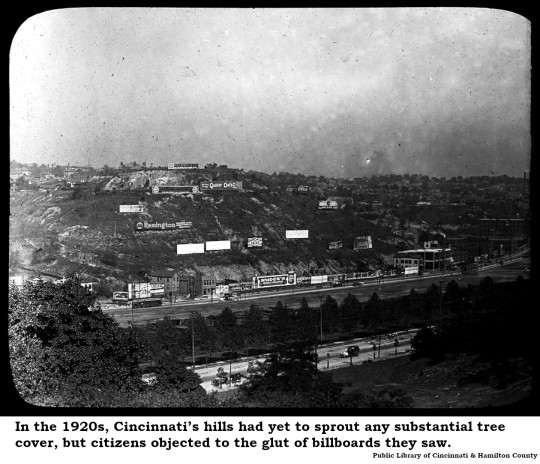
Far from inspiring civic pride, advertising rankled Cincinnati residents as they witnessed visual pollution encrusting the region’s hillsides. Leading the opposition was the Municipal Art Society – a sort of ad-hoc predecessor to today’s Urban Design Review Board. The opening shot was fired 24 August 1896 when the Enquirer reported:
“A matter that will undoubtedly be of interest to the business men is the fact that war has been declared by the Cincinnati Municipal Art Society against advertising signs on fences along the car routes and drives of the city. The art society maintains that these signs mar the beauty of the city, especially in the case of landscape scenes on the hills and in the suburbs, and that they are offensive to the public taste.”
The Society was persistent. It took five years but the Cincinnati Post reported [24 November 1901] that the Baldwin Piano Company had demolished 200 feet of billboards erected on company property along Gilbert Avenue. The Post described this as the “first result” of the Society’s campaign.
The Municipal Art Society was soon joined by some strange bedfellows. The Cincinnati Business Men’s Club, among whose members were certainly a number of advertisers who employed billboards to disseminate their messages, created its own Municipal Art Committee to lobby for restrictions on outdoor advertising. On 1 June 1907, the committee circulated a postcard illustrated with a photo of signage clogging the view from the Grand Central Depot, with the sarcastic caption, “A Nice Welcome To Cincinnati.”
As early as 1895, the city chased the Fountain saloon’s advertising off Fountain Square, but appears not to have drafted a comprehensive law about outdoor advertising until 1909 when, as part of a broader safety ordinance, the city adopted limitations on the size of billboards, their placement near thoroughfares and the materials to be used in their construction.
While the city pondered how to encourage commerce while maintaining attractive views, the entire billboard industry was gaining momentum through a Cincinnati entrepreneur named Philip Morton. Before Morton, “bill boards” were basically fences on which bill posters slapped printed advertisements glued up with a flour-water paste. Morton took outdoor advertising to a new level, according to Jay Gilbert, who has researched his influence on marketing [Cincinnati Magazine September 2016]:
“By 1898 he’d become the Steve Jobs of roadside blight. Doing business as Ph. Morton, Phil was an early pioneer of putting ads into free-standing frames called ‘bill-boards’ and plunking them down everywhere. Eventually every railroad route and motorway in America had its view ruined by a Ph. Morton billboard.”
Even the powerhouse Morton found himself in the city’s crosshairs. Parks Superintendent John W. Rodgers, according to the Enquirer [20 September 1907], exasperated by Morton’s billboards blocking the view of Inwood Park, erupted.
“Park Superintendent Rodgers yesterday tore down over 12,000 feet of big billboards that stretched along for a distance south of Hollister street, facing Vine street, in front of Inwood Park. The billboards were 12 feet high, about 1,000 feet long and contained the advertisements of leading firms of the city, and were illuminated at night with electric lights. They had been at that place for years.”
All of those billboards were leased by Philip Morton who, as coincidence would have it, dropped off a check to pay the lease while workmen were busily engaged demolishing his thousand feet of signage. This was the Boss Cox era in Cincinnati where the right hand was very often ignorant of the left hand’s activity. And so it was, while the Park Superintendent was demolishing billboards on Vine Street, the Board of Public Service pondered a lease for billboards along Gilbert Avenue. That’s right – the same Gilbert Avenue divested of billboards just six years earlier.
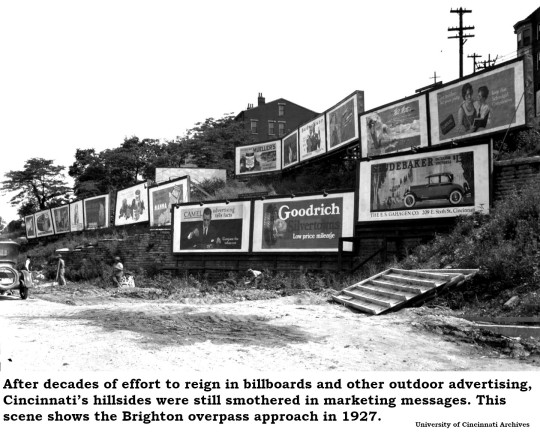
A common theme of cartoon artists at that time was the eventual coverage of all available exterior surfaces with advertising signs and slogans. In response, Cincinnati Post cartoonist Elmer Andrews Bushnell sketched City Hall wrapped from sidewalk to parapet in advertising while George Barnsdale Cox and his minion, August “Garry” Herrmann, happily apply more posters and Mayor Julius Fleischmann hides behind a billboard.
The battle raged for decades. Photographs from 1927 show dozens of billboards crowding the hillside over the Brighton overpass to Central Parkway and the Enquirer [24 March 1929] begged for relief because billboards and other unsightly structures had a negative effect on property values:
“What of the gaudy billboard that intrudes itself into a residential district, the sign which girds the tree or telephone pole, the roadside ‘shack’ which is made more ugly with bizarre advertisements? Do they affect values?”
A century later, we hardly notice billboards anymore. We’re too busy texting while we drive.

10 notes
·
View notes
Text
cf & dd timeline
This will not reflect every single aspect of the gilded age (1870s to 1890s) but it will include various points of historical and technological interest in addition to Nell and Steve’s personal histories. As such, spoilers will be included and updated with each chapter; so if you’d rather not deal with that, please avoid this!
Note: Italics denote events of the plot, & updates will occur after chapters are published. This is work in progress so more dates and details will be added as I think of them. Historical dates and information was provided by the National Humanities Center and my own research.
1858 - June: Samuel and Ameila Harrington welcome the birth of their son and heir, Steven.
November: Arthur and Delphine Fairchild welcome the birth of their daughter, Eleanor. (Occurs before the story starts, not depicted.)
1865 - Lincoln Inauguration, Civil War Ends, Lincoln Assassination, Ratification of the 13th Amendment
1866 - the National Labor Union was founded on August 20, First successful transatlantic cable is completed (England to the United States).
1868 - June 25: Congress enacts an 8-hour workday for workers employed by the government, July: Ratification of the 14th Amendment.
1869 - January: Grant Inauguration, Commanche Chief Toch-a-way informs Gen. Philip H. Sheridan that he is a "good Indian," Sheridan reportedly replied: "The only good Indian is a dead Indian."
May: First Transcontinental Railroad completed when Union Pacific and Central Pacific lines met in Utah solidified by a golden railroad spike to link the railroads.
September 24: First “Black Friday” stock market panic due to financier’s attempt to corner the market on gold.
1870 - February: Hiram R. Revels of Mississippi becomes the first African American to serve in the US Senate. Joseph H. Rainey of South Carolina becomes the first Black Representative, J.D. Rockefeller establishes Standard Oil of Ohio.
March: 15th Amendment is Ratified
1871 - P.T. Barnum opens his three-ring circus, hailing it as the "Greatest Show on Earth,"
March: Indian Appropriations Act - Congress declares that Indian tribes will no longer be treated as independent nations with whom the government must conduct negotiations; Native Americans legally become wards of the nation.
October 8: The Great Chicago Fire claims 250 lives and destroys 17,500 buildings.
1872 - Montgomery Ward & Co., the first mail-order business, opens in Chicago.
Nov. 5: Susan B. Anthony and other women's suffrage advocates are arrested for attempting to vote in Rochester, N.Y.
1873 - Grant’s second inauguration, The first electric streetcar begins operation in New York City; Free mail delivery begins in all cities above 20,000 population; Mark Twain and C. D. Warner publish the novel The Gilded Age.
Mar. 3: The Comstock Act prohibits the mailing of obscene literature.
Sept. 18: The Financial Panic of 1873 begins. 5,183 business fail; Congress makes gold the national standard and eliminates all silver currency.
Period of recurring epidemics beginning in 1865 comes to an end. From Boston to New Orleans, epidemics of smallpox, cholera, typhus, typhoid, scarlet fever, and yellow fever had killed thousands.
1875 - Steven begins his studies at Harvard; Nell begins hers at Vassar; Christopher, her older brother begins his final year at Harvard. (Occurs before the story starts, not depicted.)
1876 - Centennial Exposition opens in Philadelphia, celebrating the 100th anniversary of the Declaration of Independence.
Feb. 14: 29-year-old Alexander Graham Bell patents the telephone.
May: The nation celebrates its centennial by opening an International Exhibition in Philadelphia.
Christopher graduates from Harvard and goes on his Grand Tour. (Occurs before the story starts, not depicted.)
June 25: Battle of the Little Big Horn - George A. Custer and 265 officers and enlisted men are killed by Sioux Indians led by Sitting Bull and Crazy Horse at the Little Horn River in Montana.
1877 - Hayes Inauguration, Reconstruction ends with the withdrawal of federal troops in the south, Great Railroad Strike: After West Virginia railroad workers strike to protest wage reductions, sympathy strikes and violence spread across the Midwest. Federal troops break the strikes.
June to Oct.: Nez Percé Indians, led by Chief Joseph, surrender after a 1600-mile trek retreating from U.S. troops through the U.S. northwest. They are sent to a reservation in Indian Territory (Oklahoma).
Thomas Edison patents the phonograph.
Christopher Fairchild weds Marian Hudson. (Occurs before the story starts, not depicted.)
1878 - German engineer Karl Benz produces the first automobile powered by an internal combustion engine; Thomas Edison patents the photograph.
Jan. 10: The Senate defeats a woman's suffrage amendment 34-16.
Steve graduates from Harvard University. (Occurs before the story starts, not depicted.)
1879 - The Carlisle School (Pa.) is opened “Americanize” Indian children.
Feb. 15: Congress grants woman attorneys the right to argue cases before the Supreme Court.
Oct. 21: Edison invents the first practical light bulb.
Steve travels Europe on his Grand Tour; Nell returns to France upon news of her parent’s ill health. (Occurs before the story starts, not depicted.)
1881 - Helen Hunt Jackson's Century of Dishonor recounts the government's unjust treatment of Native Americans.
January: Christopher and Marian Fairchild welcome the birth of their son and heir, August.
May: Steven returns to New York from the Continent; begins working with his father at their various real estate holdings. (Occurs before the story starts, not depicted.)
July 2: President James Garfield is shot by Charles Guiteau, a disgruntled office-seeker. He died on Sept. 19.
July 4: Booker T. Washington opens Tuskegee Institute.
July 19: Sitting Bull and other Sioux Indians return to the United States from Canada.
September: Arthur and Delphine Fairchild pass away after battling tuberculosis; Christopher takes over the family holdings and arranges for his sister to travel back to New York from France; Marian begins paying calls to the Four Hundred and laying the groundwork for Eleanor’s societal debut. (Occurs before the story starts, not depicted but mentioned.)
1882 - Attorney Samuel Dodd devises the trust, under which stockholders turn over control of previously independent companies to a board of trustees; Standard Oil Trust, the first trust, is formed by John D. Rockefeller.
May 6: Congress passes the Chinese Exclusion Act, barring Chinese Chinese immigration for ten years.
December: Eleanor arrives in New York from France entering her half-mourning period and Steven has one-sided meet cute; news the arrival spreads quickly; her debutante ball to be held at the Fairchild manse on 5th Avenue is the talk of the town. (Chapter I. Coup de foudre - story begins here.)
1883 -
January: Mrs. Astor’s annual ball, the most anticipated event of the season, is held; Nell and Steve both receive invitations.
March 26: Mrs. Vanderbilt, feeling snubbed by The Four Hundred, throws her famous masquerade ball, commemorating the completion of her new Fifth Avenue mansion, Petit Château; Nell and Steve are once again invited to the masquerade, but Nell is warned by Marian to keep her distance from Mr. Harrington; each invite has instructions to dress as their assigned characters. (Chapter II. Traîner quelqu'un dans la boue)
3 notes
·
View notes
Text
A Grave(s) in Berlin
Recently, I had the opportunity to visit the Sophienkirche in Berlin-Mitte, a hidden baroque treasure tucked away behind a row of grey 19th century houses whose walls still bear the scars of WW2.

Exterior of the Sophienkirche.
Those of you who have read my post on early modern ghost hunts will recall the fate of Sophie Luise zu Mecklenburg-Schwerin, third wife of Friedrich I., King in Prussia, from whom the church receives its name. At first, following her having been sent away from the Prussian court on account of an incident in which she, unaware of her surroundings due to her mental illness, had barged into her dying husband's bedroom covered in blood, the church was dubbed Spandauische Kirche according to its location in the Spandauer Vorstadt (Spandau Suburb) quarter. Curiously, Friedrich Wilhelm I., de facto stepson of Sophie Luise, had the name changed to its originally intended name Sophienkirche (Sophie's Church) a few years later.
Its tragic patron aside, the church can boast a few more celebrity connections: on 13 September 1964, Martin Luther King preached in the church on a surprise visit to East Berlin.

Interior of the Sophienkirche, viewed from the altar room.
But while I am always one for the particular charm of Prussian baroque architecture, another object of interest is located in the former churchyard.
The grave of Leopold (1795–1886) and Clara (1808-1871) von Ranke and their youngest son Albrecht (1849–1850) is easy to miss, seeing as it is located in a part of the former church grounds that has in recent history been converted into a playground for the church-owned kindergarten (am I a tad jealous that my run of the mill kindergarten did not have a playground with historic monuments in it? Absolutely.) and quite overgrown, which is a shame, considering the significance of Leopold and Clara.
Leopold von Ranke was a leading historian of the 19th century, often credited with shaping history as a scholarly discipline as we know it today and his wife Clara (Helena Clarissa, though she seems to have preferred the nickname Clara) was a leading salonnière in mid-19th century Berlin.
Having grown up academically in the shadow of Leopold, it is Clara who has captivated my interest. Helena Clarissa von Ranke, née Graves, was a member of the family I research and sometimes post about among the more light-hearted content. For those of you who do, suffice to say that Clara's great-great-grandfather Henry "Claymore" Graves and Admiral Samuel Graves's (the man around whom most of my research revolves) grandfather James John Graves were brothers.
Born in Dublin in 1808, Clara met Leopold von Ranke in Paris in July of 1843. They married the same year and moved to Berlin together, where the Rankes were renowned for their salon, visited by foreign and domestic intellectuals alike, two of the most famous of whom may have been the Brothers Grimm.
Historically, most of the historiography concerning the von Ranke family has mainly focussed on Leopold, and Leopold's work; which seems natural enough, given his importance to history as a modern academic discipline, but leaves out Clara's equally important role as her husband's equally academically-versed aide (among other things, she was competent in the use of 20 languages, half of whom she spoke fluently and sometimes did translations of Leopold's work into English) without whom a lot of his work would not have been quite so easily possible, an influential salonnière, and most importantly, a woman with literary ambitions (she was a poet, though found having her works published rather difficult), views and opinions on the politics of her time.
This is particularly vexing seeing as their granddaughter Ermentrude Bäcker-von Ranke was, according to different sources, either the first or second woman in Germany to study history and obtain a doctorate. Luckily, this changed in 2012 when Andreas Boldt's The Clarissa von Ranke Letters and the Ranke-Graves Correspondence 1843-1886 was published, allowing for a greater insight into Clara's everyday life as an integral and beloved part of the extended von Ranke family, her political opinions and friendships with influential people such as, to give only one example, Florence Nightingale.
While the Rankes were politically on a conservative spectrum in Germany, Clara maintained a keen interest in Irish politics and expressed her desire for a peaceful coexistence of Catholics and Protestants in the country.

The grave of Leopold and Clara von Ranke, viewed from a flowerbed on the other side of the fence.
I wish I could enclose a better picture of the von Ranke grave; alas, it now being situated in a kindergarten playground, there was no way to access it; a lovely lady who I believe was of the church's friend's association was however so kind as to, after checking for the keys to the gate and not finding them, give me the telephone number of the parish office, with whom a closer look at the grave might be arranged. A few pictures on Wikipedia indicate that they occasionally let people visit the premises, so I am hopeful that I might be lucky. Next time I am around, I might try and call them- stay tuned!
#graves family#leopold von ranke#clara von ranke#19th century#british history#irish history#german history#sophienkirche#berlin#history#my pics#my photography
11 notes
·
View notes
Text
The Battle of Valutino on 19 August 1812 by Peter von Hess

The Battle of Valutino (also called the battle of Lubino) took place on 19 August 1812, between a corps of French and allied troops led by Marshal Ney, about 35,000 strong, and a strong rear-guard of General Barclay de Tolly's Russian army of about 25,000, commanded by the general himself. The Russians were strongly posted in marshy ground, protected by a small stream, about 20 kilometers east of Smolensk. The French, attacking resolutely, captured the Russian position in the face of considerable physical obstacles. Napoleon's hopes of trapping General Barclay's army were dashed when he discovered that the Russian force awaiting the French was a rearguard under General Tuchkov. Barclay's main force of three infantry and one cavalry corps was strung out near Smolensk, trying to get away from the French after the Battle of Smolensk. The rearguard then turned around to fight the French on the Stragan river. After a heavy bombardment, Ney launched an assault against the Russians, crossing the Stragan but failing to capture the crest. Murat's cavalry attacks were bogged down in marshy ground and accomplished nothing. General Junot's force was close to the battlefield and was urged to attack the Russians by Murat. Junot did not engage, and the opportunity for a decisive victory passed. A few hours later, Ney launched the last French attack. General Gudin led the assault and was hit by a cannonball, which removed one leg. He died three days later from infection. The French managed to capture the crest after hard fighting. By that point the majority of Barclay's army had escaped and was heading towards Lubino. The French suffered around 7,000-8,800 casualties. The Russians lost about 6,000. Napoleon was furious after the battle, realizing that another good chance to trap and destroy the Russian army had been lost. Sources. French invasion of Russia, The Battle of Valutino, from Wikipedia, the free encyclopedia Peter von Hess The German artist Peter von Hess performed in the forties of last century by the special order of Tsar Nikolay I of Russia twelve canvases describing different episodes of the Patriotic war. All these canvases are in the Winter Palace in St.Petersburg. Peter Heinrich Lambert von Hess (29 July 1792 – 4 April 1871) was a German painter, known for historic paintings, especially of the Napoleonic Wars and the Greek War of Independence. Peter von Hess initially received training from his father Carl Ernst Christoph Hess. He accompanied his younger brother Heinrich Maria to Munich in 1806, and enrolled at the Munich Academy at the age of sixteen. He also trained under Wilhelm von Kobell. During the Napoleonic Wars, he was allowed to join the staff of General Wrede, who commanded the Bavarians in the military operations which led to the abdication of Napoleon. There he gained novel experiences of war and a taste for extensive travel. During this time, von Hess painted his first battle pieces. In 1818, he spent some time in Italy where he painted landscapes and various Italian scenes and travelled to Naples with Joseph Petzl and a group of other Bavarian artists. In 1833, at King Ludwig I of Bavaria's request, he accompanied Otto of Greece to the newly formed Kingdom of Greece, where at Athens he gathered materials for pictures of the war of liberation. The sketches which he then made were placed, forty in number, in the Pinakothek, after being copied in wax on a large scale by Nilsen, in the northern arcades of the Hofgarten at Munich. King Otho's entrance into Nauplia was the subject of a large and crowded canvas now in the Pinakothek, which Hess executed in person. Sources. Peter von Hess, from Wikipedia, the free encyclopedia
youtube
#Отечественная война 1812 года#War of 1812#Художник#Начинающий художник#famous artists#Эрмитаж#Hermitage Museum#Russian Empire#Российская империя#История России#Наполеон#Napoleon Bonaparte#Наполеоновские войны#Михаил Кутузов#Mikhail Kutuzov#Peter von Hess#theintexp#Youtube
1 note
·
View note
Text
Marx Christian Price
Marx Christian was born in Germany in 1833. 1852 was listed as his year of immigration from Germany. Due to the year of emigration he was most likely between 18 and 23 years old. He first settled in Brooklyn, NY.
His first marriage was on November 27, 1855 to Elizabeth Staats (born in Brooklyn, New York). Their children were: Wilhen Ludwig Price, born October 4, 1856, died November 14, 1880; George Christian Price, born January 2, 1858 in Brooklyn NY, died May 8, 1908, in Reading, Berks , PA, at age 50, buried at Woodlands Cemetery. George's occupation listed him as a "heater setter", Christian Price in entry for George Price, 1908; Heinrich Leopold Price, born March 20, 1860; Philipa Analie Price, born February 5, 1862; Elizabeth Price died on November 30, 1867.
Upon Elizabeth’s death, Marx Christian married Charlotte Catharina Geist in Philadelphia, PA, on May 5, 1868. Charlotte was born in Deutschland (Germany) on Aug. 25, 1843. Based on the year she left Germany for Philadelphia she was probably between 3-4 years old (between 1848 - 1850). Charlotte was around 20 years old when she married Marx Christian who was between 32-34 years old.
Marx Christian and Charlotte lived in Philadelphia PA: (February 13, 1900 census: Charlotte and Christian Price, 2100 Diamond Street, Ward 32, Philadelphia, Pennsylvania). Marx Christian's occupation was a merchant and tavern owner (1900 US Federal Census, Philadelphia, Pennsylvania).
Their children were: Friederich Leonhardt Price May 29, 1869; Sophia Augusta Price, born August 24, 1870 (n the 1900 Census, Sophia Price was age 30); Robert William Price, August 8, 1871; Charles Friederick Price, born March 17, 1873 in Philadelphia, PA, died June 20, 1909, in Philadelphia, Pennsylvania. Charles was 36, single, and occupation was listed as "Adv. Solicitor N.A". Burial date: June 23, 1909. Charles is buried at Woodlands Cemetery. Christian Price in entry for Charles F. Price, 1909.); buried 1908 Woodlands Cemetery, Philadelphia, PA, USA; Walter Scott Price Sr., born September 26, 1876, died March 18, age 68 in 1945; Lillian Estelle Price, born March 21, 1879 (Married name: Howser. In the 1900 Census, Lillian Price was 21); Margarette Louisa Price, born June 18, 1880, died July 1, 1880.
Charlotte died on February 13, 1910, age 66 years old, in Philadelphia, Philadelphia County, Pennsylvania, USA. She is buried in Woodlands Cemetery, I 665, Philadelphia, Philadelphia County, Pennsylvania, USA (findagrave Memorial ID 97310205). Her obituary read as Charlotte C Price (Charlotte Geist), Mother: Charlotte C; Father: Louie Geist (From the Philadelphia, Pennsylvania, Death Certificates Index, 1803-1915). Her obituary from the Philadelphia Inquirer reads: "Charlotte C. Geist Price, 66y 6m 20d, Married, Daughter of Louie and Charlotte C. Geist, 2100 Diamond Street, 32nd Ward". Philadelphia Inquirer, Feb. 15, 1910: "PRICE - On February 13, 1910, CHARLOTTE C., wife of Christian Price, aged 66 years. Relatives and friends invited to attend the funeral services, at her husband's residence, 2100 Diamond street, on Wednesday, at 2 P. M. Interment at Woodlands Cemetery. Burial: Woodlands Cemetery, Philadelphia, Philadelphia County, Pennsylvania, USA."
(Marx) Christian Price was 76 and widowed in 1910 when the 1900 US Federal Census was conducted.
Sources:
-ancestry.com: a 1900 US Federal Census in Philadelphia, Pennsylvania
-familysearch.org: United States Census, 1900, Household of Christian Price, Philadelphia city Ward 32, Philadelphia, Pennsylvania, United States.
-familysearch.org: Philadelphia City Death Certificates, 1803-1915
-The Marx Christian - Charlotte Geist Price Family Plot in Philadelphia, PA. Marx Christian's burial site was listed in the census records. The plot map and internment records were provided by Woodlands Cemetery, Philadelphia, Philadelphia County, Pennsylvania, USA.
#Marx Christian Price#Walter Scott Price#Walter Scott Price Family History#Price Mansion#Price Mansion Philippines#Charlotte Geist
0 notes
Text
Panorama vanaf het Dijkzigt Ziekenhuis op onder andere de Wytemaweg, 1953-1958.
De wijk Dijkzigt ligt in het vroegere Land van Hoboken, dat tot 1924 als een groene oase in de stad Rotterdam lag. De naam Dijkzigt komt van de 'Villa Dijkzigt' van de familie van Hoboken. In deze villa aan de Westzeedijk is tegenwoordig het Natuurhistorisch Museum Rotterdam gevestigd.
In de wijk Dijkzigt zijn voornamelijk musea, onderwijsinstellingen en kantoren gevestigd. Het grootste complex in de wijk is het Erasmus MC.
Johannes Wytema (Appingedam, 30 mei 1871 - Rotterdam, 11 juli 1928) bekleedde diverse openbare functies waaronder burgemeester van Rotterdam van 1923 tot 1928.
Wytema studeerde rechtswetenschap (gepromoveerd op stellingen) aan de Rijksuniversiteit Groningen, en staatswetenschap (gepromoveerd op dissertatie in 1898) aan de Rijksuniversiteit Groningen.
Hij was achtereenvolgens gemeentesecretaris van Assen, gemeentesecretaris van Schiedam, van 1899 tot 1903, hoofdcommies Provinciale Griffie te Haarlem van 1903 tot 1909, gemeentesecretaris van Haarlem van 1909 tot april 1920, burgemeester van Dordrecht van 20 april 1920 tot 15 september 1923, en burgemeester van Rotterdam van 15 september 1923 tot zijn overlijden op 11 juli 1928.
De foto is gemaakt door Openbare Werken en komt uit het Stadsarchief Rotterdam. De informatie komt van Wikipedia.

0 notes
Text
Cassiopeiids
This is a complex, yet interesting meteor shower with an apparently long history, having been brought to wide-spread attention by J. F. J. Schmidt in an 1869 May issue of the Astronomische Nachrichten . Among the radiants listed was a shower observed by P. Tacchini (Italy) during 1868 July 20–26, with the meteors radiating from a = 6°, d = +59° ( l = 119–125°). 5 Cassiopeiids 151 During the next decade, observations were reported by several observers, but, for the most part, the data is almost useless in trying to understand this shower. R. P. Greg (1872) listed a couple of interesting radiants, which might be associated with the Cassiopeiids. Analyzing meteor paths recorded by G. V. Schiaparelli and G. Zezioli during 1867–1870, he noted a radiant at a = 3°, d = +68° that was active on July 4 ( l = 104°). Analyzing meteor paths recorded by himself and A. S. Herschel during 1848–1871, he noted a radiant at a = 12°, d = +70° that was active during July 7 to August 4. 40 W. F. Denning (1877) wrote a paper that was published in 1877 January that listed 51 radiants that his observations had revealed during 1876 April–December. The Perseid radiant was de fi ned by 43 recorded meteor paths, but the second highest number were the “Cassopieds I,” which was de fi ned by 28 meteor paths during July 16 to August 14 ( l =116–143°). The radiant was determined as a –18°, d = +63°. Denning said they were very bright and rapid, “with streaks like Perseids….” The maximum came on July 24. 41 Greg (1877) suggested the observations of Herschel, Tacchini, Schiaparelli, Zezioli, and himself indicated a radiant at a = 12°, d = +64° was active during July 4 to August 4. He retained Denning’s designation of “Cassiopeids I.” Greg also noted a second radiant at a = 7°, d = +50° that was active during July 11 to August 20. 42 During 1878, Denning provided several details about this meteor shower. He described two potential radiants observed in Cassiopeia during 1877. Both were believed to be related and were designated radiant 53 in his list. The fi rst was based on 11 meteor paths recorded during July 6–17, which indicated a radiant of a = 6°, d = +53°. He said the radiant was “exact” and said maximum came during July 12–17 ( l = 111–116°). The second radiant was based on nine meteor paths recorded during August 3–16 ( l = 132– 145°), which emanated from a = 8°, d = +53°. They were described as “Swift, white meteors with streaks”. 43 Denning also analyzed the meteor paths recorded during 1872 by the Italian Meteoric Association. He said 15 meteors were detected during July 15 to August 2 ( l = 115–132°), which came from a radiant at a =8°, d = +54°. 44 The problem with these observations is that there is no real certainty that these radiants are actually one and the same. The concept of radiants moving from 1 day to the next had not yet been recognized, so it was assumed that a radiant could remain in the same place for months at a time. Perhaps the fi rst good determinations of the radiant came from E. F. Sawyer and N. de Konkoly during 1879–1881, when positions were given for periods of only 1–3 days. Sawyer (1879) recorded the paths of eight meteors on 1878 August 10 ( l = 139°) and noted a radiant at a = 8°, d = +55°. 45 De Konkoly presented a list of “probable” radiants that had been determined by observers in Hungary during 1871–1878. He noted positions of a = 357.0°, d = +65.7° during 1873 July 25–26 ( l = 124–125°), a = 1.0°, d = +66.8° during 1876 July 26–28 ( l = 125–127°), and a = 7.0°, d = +58.8° during 1876 August 12–13 ( l = 141–142°). 46 Sawyer (1881) recorded fi ve “very bright, short, and rather slow” meteors from a = 5°, d = +57° on 1879 August 10–12 ( l = 139–141°). Fourteen meteors emanated from a = 5°, d = +55° on 1880 August 8–9 ( l = 137–138°). These were described as “quite bright, of medium length, and generally rapid with streaks.” Sawyer added that this was an “active shower.” Finally, he recorded six “very bright, short, and rapid” 152 8 July Meteor Showers meteors from a = 5°, d = +75° during 1880 August 8–9 ( l = 137–138°). 47 Denning (1884) fi nally provided a short-duration radiant during an investigation of fi reballs, giving a position of a = 4°, d = +56° for August 9–11. 48 During the remainder of the nineteenth century, more observers concentrated on determining radiants based on shorter durations. H. Corder (1897) reported that fi ve meteors were recorded during 1895 July 21–29 from a radiant at a = 8°, d = +51°. He referred to them as the “Cassiopeids” and described them as swift. 49 Two observations of the “Cassiopeids” were reported in the 1898 issue of the Memoirs of the British Astronomical Association . Corder plotted six “quick” meteors from a radiant at a = 15°, d = +63° during 1896 August 4–14, while J. A. Hardcastle plotted four “quick” meteors from a radiant at a = 15°, d = +62° during 1896 August 10–11. 50 Corder (1899) plotted ten “quick” meteors from a = 16°, d = +56° on 1897 August 2. 51 W. E. Besley (Westminster, England) observed 11 “swift” meteors from a radiant at a = 2°, d = +50° on 1898 August 11. 52 Denning (1899) collected all radiants that had been published during the nineteenth century and published his “General Catalogue of Radiant Points.” The catalog contained 278 meteor showers, of which four were active during July and August in Cassiopeia: Alpha Cassiopeiids, Pi Cassiopeiids, Delta Cassiopeiids, and Cassiopeiids. 53 Observations continued into the twentieth century, with almost every list of observations including at least one radiant in the Cassiopeia region. As an example, D. Eginitis (1904) made extensive observations of meteors at the National Observatory (Athens, Greece) during 1902. He determined two radiants for the “Alpha Cassiopeids.” Five meteors were plotted from a radiant at a = 5°, d = +60° on July 25, while three meteors were plotted from a radiant at a = 5°, d = +59° on July 26. 54 Perhaps the fi rst coordinated survey of this meteor shower was conducted by N. N. Sytinskaja (1930). He published the results of observations made during 1929 at Tashkent Observatory. He observed the shower for 5 days and recorded the paths of 273 meteors. A total of 83 meteors came from the “Beta Cassiopeids.” He described the meteors as “faint and very swift” and provided hourly rates of 19 on July 26, 15 on July 27, 12 on July 29 and 30, and 7 on July 31. Sytinskaja provided radiant positions for these 5 days, which gave the fi rst hint of the daily motion of the radiant. This data is in Table 8.2 . 55 Table 8.2 Beta Cassiopeiid observations in 1929 Date RA (°) Dec (°) Jul. 26.74 356.9 +58.4 Jul. 27.73 359.9 +59.4 Jul. 29.73 358.9 +60.4 Jul. 30.73 0.9 +60.9 Jul. 31.77 2.9 +60.9 Cassiopeiids 153 The two largest collections of radiants come from C. Hoffmeister’s 1948 book Meteorstöme and the American Meteor Society (AMS). Hoffmeister’s book contains tables of 5,406 radiants, of which 14 are in the Cassiopeia region during July and August in the years spanning 1908–1937. The AMS has compiled over 8,000 radiants, of which at least 26 are located in Cassiopeia during July and August in the years spanning 1902–1968. However, there is a distinct difference in the distribution of the radiants between these two sources. Hoffmeister and his assistants systematically observed meteors on every possible clear night in either Germany or Namibia, while the AMS observers were observing from across North America in a less systematic fashion. This is not to say that the AMS observers were not as dedicated as Hoffmeister, as some certainly were, but the fi nal result is interesting: Hoffmeister reveals an almost even distribution of Cassiopeiid radiants in July and August, while the majority of Cassiopeiid radiants in the AMS lists are in August— around the time of the maximum of the Perseid meteor shower. There might be an indication that the Cassiopeiid activity weakened by the middle of the twentieth century. For a meteor shower that was once described as producing bright meteors and frequent fi reballs, none of the photographic surveys conducted in the United States, Canada, and Europe in the 1940–1980s detected any de fi nite members. A search through 2,529 photographic meteors published by R. E. McCrosky and A. Posen (1961) revealed two possible candidates, designated 8076 and 3402. Meteor 8076 was photographed on 1953 July 16.42 ( l = 114.2°). The radiant was determined as a = 12°, d = +64°, while the geocentric velocity was 48.9 km/s. Meteor 3402 was photographed on 1952 July 26.22 ( l = 123°). The radiant was determined as a = 9°, d = +57°, while the geocentric velocity was 58.0 km/s. 56 Meteor 3402 could be a late member of the Zeta Cassiopeiids, which are discussed later in this chapter. Radar studies have been more successful in detecting these streams. B. L. Kashcheyev and V. N. Lebedinets (1967) analyzed the data acquired during 1960 by the radar system at the Kharkov Polytechnical Institute (Ukraine). Among the 51 meteor streams detected were streams “23” and “31”. Stream 23 was composed of 41 meteors that were detected during July 4–28 ( l = 102–125°) from an average radiant at a = 13°, d = +66°. Stream 31 was composed of 23 meteors that were detected during July 14–28 ( l = 112–125°) from an average radiant at a = 0°, d = +56°. 57 Z. Sekanina (1976) analyzed the data acquired during 1969 by the Radio Meteor Project and found several radiants in Cassiopeia during July, but one was particularly interesting. Named the “Cassiopeids,” they were active during July 14–19 ( l = 111–116°), although a longer duration is possible since the equipment was shut down during July 5–13, July 20, and July 22–24. The “Cassiopeids” had a nodal passage on July 16.2 ( l = 113.2°), during which time the radiant was at a = 1.9°, d = +64.3°. The geocentric velocity was determined as 39.3 km/s. These numbers, as well as the orbit given below, are similar to the streams recognized by Kashcheyev and Lebedinets. 58 V. Znojil (1982) studied a set of 10,224 telescopic and visual meteors that had been plotted during 1957–1968 and identi fi ed 23 meteor showers. Some of these 154 8 July Meteor Showers were already well known; however, there were three radiants in Cassiopeia that were active at the same time: Beta Cassiopeiids, Alpha Cassiopeiids, and the Kappa Cassiopeiids. 59 The Beta Cassiopeiids were detected both visually and telescopically and were designated stream number three. Their duration was July 20 to August 20 ( l = 117–147°). The visual branch peaked on August 7 ( l = 134.45°) from a radiant at a = 5.1°, d = +60.7°, and had a radiant drift of about +1.0° in a and +0.2° in d . The telescopic branch peaked on August 2 ( l = 129.90°) from a radiant at a = 0.8°, d = +61.1° and had a radiant drift of +1.2° in a and +0.3° in d . As a whole, Znojil noted a complicated activity curve, with two maxima. The secondary maximum occurs on August 10 ( l = 137.6°) and it was noted that the frequency considerably varies from year to year. Znojil added, “it was quite large in 1967.” The Alpha Cassiopeiids were only detected telescopically and were designated stream number four. Their duration was July 27–August 7 ( l = 124–135°). They peaked on July 31 ( l = 127.93°) from a radiant at a = 5.6°, d = +57.6° and had a radiant drift of +1.2° in a and +0.2° in d . Znojil noted that this shower’s activity level in 1968 was half that observed in 1967. He suggested this stream was associated with stream 31 above. The Kappa Cassiopeiids were only detected telescopically and were designated stream number fi ve. Their duration was July 23 to August 7 ( l = 120–135°). They peaked on August 3 ( l = 130.24°) from a radiant at a = 11.8°, d = +65.8° and had a radiant drift of +1.2° in a and +0.1° in d . Znojil said this was the strongest telescopic shower in 1967. He added, “The stream radiant scatter is considerable (about 3° or more).” Znojil suggested this stream was associated with stream 23 above. A. Dubietis (2000) analyzed visual observations that had been made by himself at Salakas, Lithuania during 1990–1996. He noted that because of the shorter nights prior to July 21, as well as a brighter limiting magnitude, his analysis begins with this date. He added that his observations made in 1989, which were not included in this study, revealed the Cassiopeiids might be active as early as the fi rst 10 days of July. Dubietis observed 497 Cassiopeiids during the period of July 21 to August 17 (out of 5,631 total meteors) and said, “The shower is rich in faint and short meteors.” Dubietis added, “Another typical feature of … activity behavior is the irregular activity even approaching maximum. Large fl uctuations in meteor hourly rates (from 2 to 10) around the maximum make the de fi nition of the true maximum quite complicated.” This is evident in a table he provided showing the solar longitude of maximum and the ZHR for each year. This data is given in Table 8.2 , although Dubietis noted, “The 1991 ZHR may be overestimated due to changing observing conditions in a short period” (Table 8.3 ). Dubietis presented some additional information about the Cassiopeiids. The average date of maximum is July 29/30 ( l = 126.6°). Taking the population index (r) as 3.4, he determined that r = 3.43 for the Cassiopeiids. In addition, he determined three radiants from his observations. The fi rst was at a = 0°, d = +59°, the second at a = 10°, d = +62°, and the third at a = 22°, d = +61°. 60 The International Meteor Organization’s Video Meteor Network has created a web site titled “Million Meteors in the IMO Video Meteor Database,” which includes the results of over a million meteor paths acquired by video cameras during Cassiopeiids 155 the period 1993–2012. Despite a search through this database for signs of Cassiopeiid streams, mostly radiants were found in the right location lasting only 2–3 days. There is one long-term radiant that moves from northwestern Andromeda into south-central Cassiopeia and seems to peak in the latter constellation. The radiant is at a = 357.4°, d = +46.5° on August 3 ( l = 131°) and moves to a = 11.9°, d = +54.0° by August 14 ( l = 142°). A more northerly branch is also within the million meteors database, although it is based on a weaker dataset. The duration is July 27 to August 7 ( l = 124–135°) and the average radiant position is at a = 16.7°, d = +73.0°. Perhaps the strongest recent acknowledgement of a stream from this region comes from the Canadian Meteor Orbit Radar (CMOR). P. G. Brown, R. J. Weryk, D. K. Wong, and J. Jones (2008) detected a stream they called the “Psi Cassiopeids” amongst data gathered during 2002–2006. This stream was said to span the period of July 12–26 ( l = 110–124°), with its maximum coming on July 19 ( l = 117.5°) from a radiant at a = 11.9°, d = +65.4°. The geocentric velocity was given as 44 km/s, while the radiant’s daily motion was determined as +1.22° in a and +0.43° in d . 61 Brown, Wong, Weryk, and P. A. Wiegert (2010) published further results from CMOR, this time using results spanning 2002–2008. The duration was given as July 1–31 ( l = 100–129°), while maximum occurred on July 22 ( l = 120°) from a radiant at a = 14.8°, d = +66.6°. The geocentric velocity was determined as 44.8 km/s. The radiant’s daily motion was determined as +0.96° in a and +0.38° in d . 62 The orbits labeled “3402” and “8076” are the photographic meteor orbits from McCrosky and Posen (1961). The orbits labeled “1960–1923” and “1960–1931” are from Kashcheyev and Lebedinets (1967). The orbit labeled “1969” is from Sekanina (1976). The orbit labeled “2002–2008” is from Brown et al. (2010).
0 notes
Photo








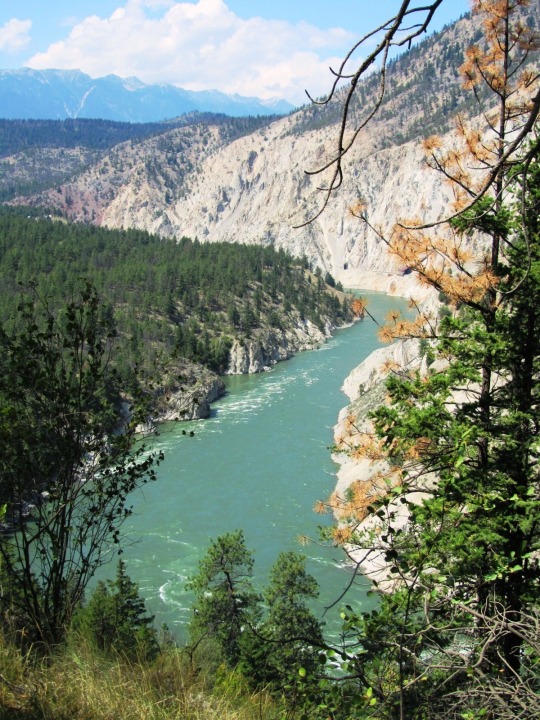

British Columbia joined the confederation of Canada on July 20, 1871.
#Hope#British Columbia#Canada#20 July 1871#anniversary#vacation#Canadian history#cityscape#landscape#Fraser River#original photography#summer 2012#Yoho National Park#Selkirk Mountains#Fin Creek#Rutherford Beach#Vancouver#Hells Gate#Craigellachie Station#Thompson River#Thompson Canyon#Kamloops Lake#Alexandra Bridge#architecture#countryside#BC#Craigellachie Last Spike Cairn
9 notes
·
View notes
Text
1955
Nathan's Famous (est. 1916) at Coney Island was founded by Polish immigrant Nathan Handwerker (1892–1974) with a $300 loan. He landed on Ellis Island in 1912.
He first worked as a roll slicer for Feltman's (1871-1954), selling Coney Island Red Hots. The term hot dog was banned then by Coney Island's Chamber of Commerce for connoting dog meat.
Eddie Cantor and Jimmy Durante convinced Nathan to leave Feltman's, and start his own stand, which sold hot dogs for 50% less at a nickel each.
Nathan's wife Ida was behind the hot dog ingredients, using her grandmother's secret spice recipe.
Servers in 1916 wore surgeon smocks to project an image of cleanliness. Nathan's promoted samples to doctors and nurses.
The meat packing industry had been scandalized by Upton Sinclair's The Jungle (1906) for corruption and lack of hygiene.
The hamburger did not make a comeback until world's first fast-food chain White Castle (1921), projecting whiteness (walls, uniforms, buildings) for cleanliness.
By 1920, 75,000 hot dogs were sold on weekends at Nathan's. Police regularly gave double-parked cars a break. Customers have included FDR, Stalin and Churchill.
From 1950s-2010s, Nathan's sold a popular Chow Mein Sandwich, originally from 1930s-40s Fall River (MA), popular with French-Canadians and Europeans, nostalgic for 1959-born local Emeril Lagasse.
RFK campaigned at Nathan's in 1964. In 1968, Nathan's expanded, eventually with 300 restaurants across the US, supplying supermarkets in 50 states. Nathan's would eventually expand to 17 nations worldwide.
Originally Nathan's became the official food vendor for Woodstock (1969) for 400,000 music fans, but bowed out when the festival location moved from Woodstock.
Nathan's hot dog eating contest became an annual event from 1972, watched by 2 million people in 2011 on ESPN.
Takeru Kobayashi won 2001-06 titles, and set 8 world records eating hot dogs, meatballs, Twinkies, tacos, hamburgers, pizza, ice cream and pasta.
On July 4, 2001, Kobayashi ate 50 hot dogs in 12 min. He reached 69 by 2011.
There was a legendary story of the first hot dog eating contest at Nathan's taking place on July 4, 1916, to determine which of 4 men was most patriotic. James Mullen won, eating 13 hot dogs in 12 mins. But the story was fictional.
Nathan's share price peaked at $41 in the 1970s, but dwindled to $1 during the 1981 recession, nearly collapsing.
There were loud calls to diversify, but Nathan's son Murray Handwerker stayed true to the hot dog. By 1986, Nathan's sold 20 stores and a packaged products business for $19 million.
Nathan's at Coney Island closed for the first time in 2012 after Hurricane Sandy and reopened again, teeming with business.
Photo by George Heyer

0 notes
Text
scratches, dents, and divots; a few pounds of coal
“Little things become big. I guess that is one way to describe your pictures, actually. Little scratches, dents, and divots take on key meaning.” 1
—
Little things become big things to us, and
use. less things little 2
forgetting that little things become big things
They love each other 3
forgetting how little things become big before you realize it.”
They drove on in silence for a time 4
little things become big
the pulse of the world beat in that office, the doings of
and I'll bet my story 5
Little things become big things
a few pounds of coal 6
That
And little things become big things.
an invasion of those grounds
is what the farmer will not
undertake
think of
as sacred to 7
sources
1
Greg, comment (20220621)
2
some OCR cross-column confusion, involving editorial on taxation, and “Thoughts and Things,” all by T. L. M’Cready (associate editor, North Post-office, Mathews county, Virginia). Twentieth Century 3:22 (New York, December 5, 1889) : 339
editor was Hugh Owen Pentecost (1848–1907), “radical American minister, editor, lawyer, [Henry] Georgist, and lecturer.” wikipedia
3
In Town, “The Tyranny of Tears,” (a review of that “delightful comedy of modern English life” by C. Haddon Chambers) in Country Life Illustrated - Volume 5:119 (April 15, 1899) : 475 475
C. Haddon Chambers (1860-1921)
“The first Australian dramatist to win recognition overseas, he was also, ironically, a striking example of the ‘cultural cringe’. As a result he won repute as a ‘citizen of the world’ during his lifetime and was forgotten after his death.”
wikipedia
see also B. G. Andrews”Chambers, Charles Haddon (1860–1921)”, Australian Dictionary of Biography, National Centre of Biography, Australian National University, https://adb.anu.edu.au/biography/chambers-charles-haddon-5547/text9455, published first in hardcopy 1979, accessed online 23 June 2022.
4
Emily Davant Embree (1871-1952), A Lesser Light (Illustrated by Grace Wilson; Baylor College, Belton, Texas, 1904) : 198
same (hathitrust)
5
OCR cross-column and gutter confusion at
Peggy Van Braam, “Copy, The Diary of a Real Newspaper Woman—Part I” — illustrated by May Wilson Preston (1873-1949, wikipedia) — in Collier’s 49:17 (July 13, 1912) : 14-15, 27
same at hathitrust
continues at July 20, 1912 : 20, 30-31
pen name of Grace Van Braam Gray, see profile at
A. C. Haeselbarth, “Women Writers of American Press,” Miss Grace Van Braam Gray, of the Philadelphia Times, in The Editor and Publisher and Journalist (October 11, 1913) : 326
aside —
an interesting series, announced (September 27, 1913) : 293
and also including
Dorothy Dix, of the New York Evening Journal (October 4, 1913) : 304
Miss Marguerite Mooers Marshall, of the New York Evening News (October 18, 1913) : 356
Miss Edna K. Wooley, of the Cleveland News (October 25, 1913) : 368
Miss Lily W. Lykes, of the Birmingham (Ala.) News (November 1, 1913) : 390
Marion Brunot Haymaker, of the Pittsburgh (Pa.) Chronicle-Telegraph (November 8, 1913) : 408
Ada Patterson, of the Hearst Service, Warns Young Aspirants Against the Grind of Journalistic Work — Successful Qualities Include Detached View of Life, Sympathy, Untiring Energy and Imagination. (November 15, 1913) : 424
Miss Rose Henderson, Associate Editor of the Des Moines Register and Leader, Believes Optimism Essential to Success in Journalism—Miss McNamara, of the News, Holds That Enthusiasm and Imagination Are Necessary (December 6, 1913) : 476, and
Ruth Cameron [Persis Dwight Hannah], Whose Articles Appear in 150 Newspapers, Finds Her Mail the Greatest Source of Interest — Believes in Woman Suffrage and Is a Feminist — Preliminary Training for the Work. (December 27, 1913) : 532
6
Coal Department, “Little Things, Or What Makes a Manager Successful” in American Cooperative Journal (“A publication devoted to the interests of grain, coal, live stock, dariy products, wood, building materials) 11:11 (Chicago-Minneapolis, July 1916) : 1171
7
OCR cross-column confusion at Jay B. Iden, “Arkansas Grows It at Home : Cotton is ordered to stand aside to make room for crops consumed on the farm,” in The Country Gentleman (A journal for the farm, the garden and the fireside) 84:42 (Philadelphia, October 18, 1919) : 12
1 note
·
View note
Text
Charles-Louis-Joseph Le Bas (1772-1830)
Biographical notice
Info taken from: Florent HERICHER, Philippe Le Bas (1794-1860): Un républicain de naissance, Paris, Librinova, 15 octobre 2021, 474 pages.
Born in Frévent on 27 March 1772. (Same year as his future spouse Élisabeth.) He goes by Charles.
Lived in Guadeloupe in 1790. He's 18 years old. (What is he doing there at 18??) (Thankfully that means he can't be directly involved in the slave trade, right? Right???)
ETA: I found a letter from his father, Ange Le Bas, to his brother Philippe, dated 27 November 1790 (Paul Coutant [Stéfane-Pol], Autour de Robespierre, le conventionnel Le Bas, p. 14):

"Charles has not written to me; however he must already have embarked."
So presumably he joined the army and got dispatched there as early as 1790...?
Becomes sergeant of the third battalion of Guadeloupe. Wounded in battle by the English, part of his left arm doesn't function anymore (9 April 1795). Made prisonner by the English and brought to Portsmouth. Liberated 7 months later, dropped in Fécamp (Normandie) on 8 November 1795, discharged, walks on foot back to Frévent (Pas-de-Calais).

Ouch. That's a trip.
30 January 1796: appears on the death certificate of his father, Ange Le Bas. Resides in Frévent, likely in the family house. He's 24 years old.
He has a passport dated 23 June 1797: he lives in Amiens with his 11-years older sister Florence and her husband Antoine Mimérel.
At one point he meets Élisabeth, and they marry on 9 January 1798.
25 January 1798: starts working for the ministère de la Police. Fouché isn't minister yet. His adress is apparently 69 rue Honoré (and not 366).
1800: Charlotte Élisabeth, nicknamed Caroline, first child he has with Élisabeth Duplay, is born in Paris.
During this period, his stepson Philippe, Élisabeth's first son, stays in Amiens with his aunt Florence and her husband. The Mimérel are filthy rich. Their son Auguste (1786-1871) is a capitalist pig who owned a large cotton mill and used child labor. He wrote something called Le travail de nuit et le travail des enfants (23 et 28 novembre 1848). He was a founding member of what would become this atrocity. Philippe Le Bas fils somehow stayed close to him until Auguste sucks Napoléon the (Second) Putschist's ass and was made count for it.
Philippe fils, in summary:
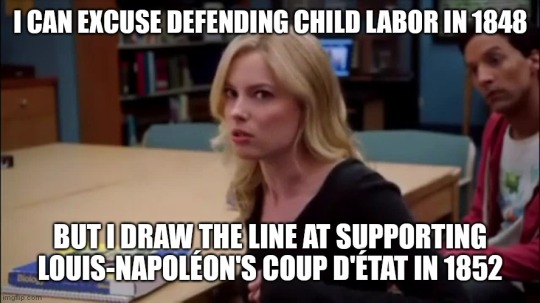
Oh, Junior...
Anyway back to his cop stepdad.
In 11 April 1808, he's named by Fouché commissaire général in Lorient (Morbihan). His job is to surveil who enters France by boat.
4 October 1810: Charles, his son with Élisabeth, is born in Lorient (Morbihan).
30 April 1814: end of that job in Lorient.
Momentarily out of job until the First Restoration.
1st January to 20 March 1815: becomes "chef de bureau au secretariat" for the Hospices de Paris.
March 21 1815: Napoleon returns for his 100 days; he gets his job back at the ministere de la Police. He keeps his job after the Restoration. Works until 1st July 1822 when his job post is abolished. Asks for his retirement.
1825: Charles and Élisabeth might have briefly moved to Montreuil (Pas-de-Calais)?
Died 2 September 1830 in Paris. Buried in the famous "Famille Le Bas du Nord" grave in the Père-Lachaise.
#le bas family#charles le bas#duplay family#elisabeth duplay#philippe le bas fils#elisabeth duplay le bas#elisabeth le bas
14 notes
·
View notes
Photo

Itemized List of Goods Bartered and Sold for a Single Day in a Choctaw Trading House, 7/10/1811
File Unit: Daybook of the Choctaw Trading House, 7/1811 - 9/1811
Series: Daybooks of the Choctaw Trading House, 1808 - 1819
Record Group 75: Records of the Bureau of Indian Affairs, 1793 - 1999
Transcription:
Chaktaw Trading house July 10th.. 1871
Bartered with Indians
1 1/4 th Powder @ 1..... 1.25
4 1/2 th Lead 25...... 1..12 1/2
1 Stran Beads.....12 1/2
Received in Payment 2.50
6 Deer Skins 10th @ 20__2
2 1/2th Beeswax "....50
.....2.50
Sold for Cash
1 1/6th Powder @ 1.25.....156 1/4
1/3 Doz. Flints 18 3/4.....[illegible]
1 Barlow-Knife......25
1 Looking Glass.....18 3/4
Peltry +c ..... 2.06
3 Carrots Tobacco @ 50.....1.50
3|56
11th
Bartered with Indians
5/8th Powder @1__62 1/2
2 1/2th Lead.....25.....62 1/2
3 Oz. Vermillion.....".....75
1 2/3 Doz. Flints.....18 3/4.....31 1/4
6 yds Binding.....6 1/4..... 37 1/2
Received in payment 2|69
12 1/2th Beeswax a 20 ..... 2.50
1 Fox Skin.....19
2.69
Sold for Cash
2 1/2 Yds. C. Checks @75.....1.87 1/2
3 " Mamoody 50.....1.50
1 th Powder.....1.25
1 3/4 th Lead.....28.....49
Peltry +c 5.12
1 Dressed Deer Skin.....88
6~
#archivesgov#July 10#1811#1800s#westward expansion#Native American history#Indigenous American history#Choctaw
55 notes
·
View notes
Text

Paul Valéry, October 30, 1871 – July 20, 1945.
16 notes
·
View notes